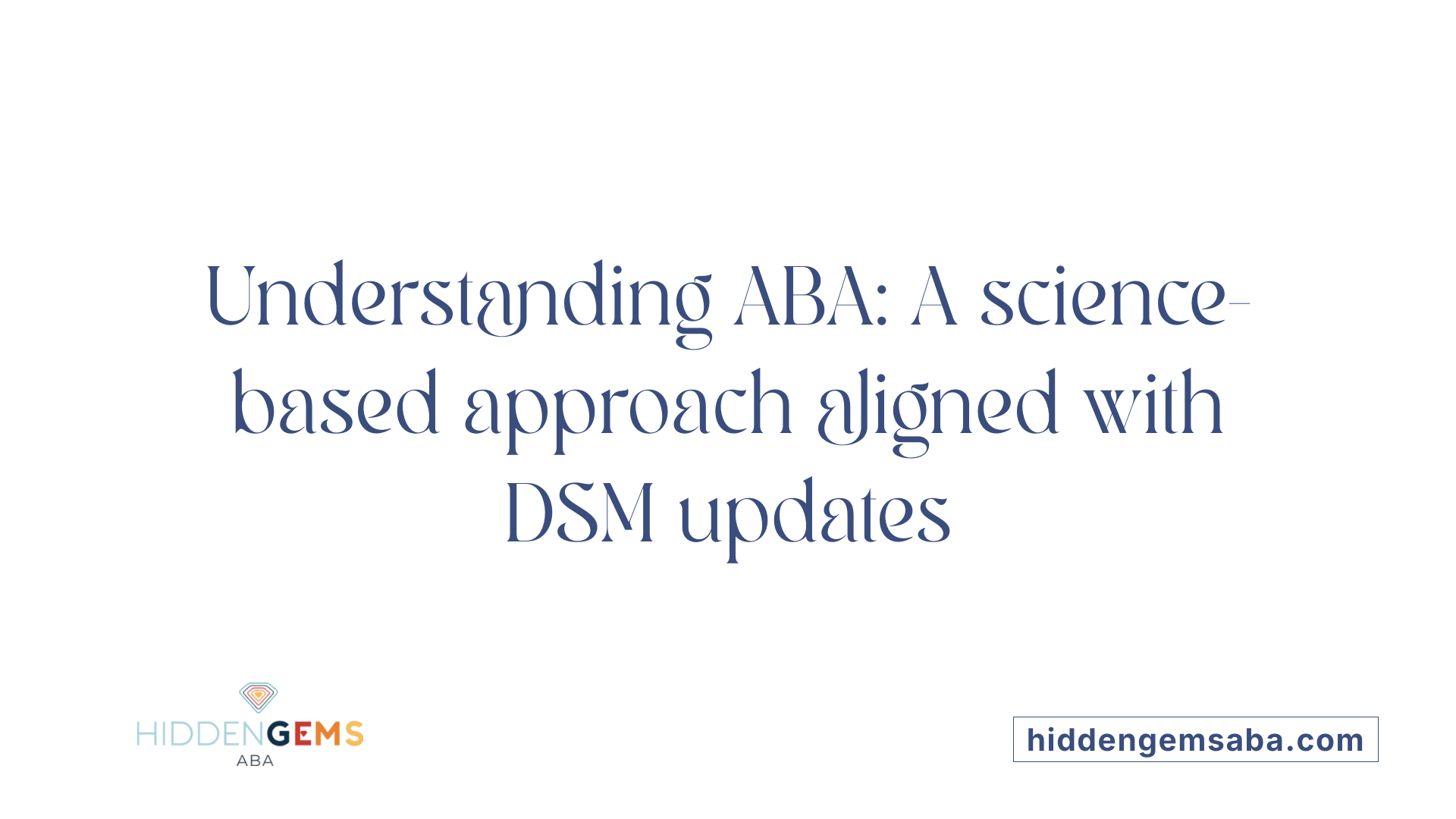Understanding the Evolution of the DSM and Its Impact on Autism Diagnosis
Since its release in 2013, DSM-5 has significantly reshaped the diagnostic landscape for autism spectrum disorder (ASD) by consolidating previous categories and emphasizing severity levels. As conversations around an upcoming DSM-6 begin, it is essential to explore how these changes have affected behavioral therapies like Applied Behavior Analysis (ABA) and to consider what advancements future revisions may bring.
The Legacy of DSM-5 and DSM-5-TR in Autism Diagnosis

What is the DSM-5 and how did it change autism diagnosis?
The DSM-5, released in May 2013, marked a significant revision in psychiatric diagnosis by reordering disorders by typical age of onset, starting with neurodevelopmental conditions. A major change was the consolidation of previous separate autism-related diagnoses—such as autism, Asperger's disorder, childhood disintegrative disorder, and pervasive developmental disorder—into one broad diagnosis called autism spectrum disorder (ASD).
This new approach focused on measuring severity in social communication, social interaction, and repetitive behaviors, incorporating sensory sensitivities into the criteria. The DSM-5 adopted a dimensional approach reflecting that symptoms often overlap across individuals and diagnoses, moving away from strict categorical distinctions.
Additionally, it enhanced consideration of cultural and gender influences on diagnosis, introducing tools for cultural assessment and recognizing cultural syndromes. The DSM-5 also integrated ICD codes to aid global reporting, billing, and reimbursement processes.
Major structural changes to autism diagnosis in DSM-5
The DSM-5 merged social communication and interaction into a single domain and combined restricted, repetitive behaviors, and sensory sensitivities into another, capturing the full range of autism spectrum symptoms. This restructuring was influenced by advances in genetics and evidence of overlapping symptoms across previous autism subtypes, supporting the spectrum model.
Furthermore, the manual introduced a new diagnosis—social communication disorder—for individuals with social challenges but without repetitive behaviors, distinguishing it from ASD.
Introduction of dimensional approach and cultural considerations
By recognizing that many psychiatric symptoms exist on spectrums rather than in discrete categories, the DSM-5's dimensional approach allows clinicians to tailor diagnoses based on symptom severity. This nuanced view acknowledges the diversity of presentations within autism and related disorders.
Cultural and gender factors received greater emphasis, with specific assessment tools and cultural syndrome descriptions included to improve diagnostic accuracy across diverse populations. This strengthens the manual's relevance in different cultural contexts.
What updates did the DSM-5-TR bring in 2022?
The DSM-5-TR, published in May 2022, is primarily a text revision that updates research findings and clarifies diagnostic criteria from the DSM-5. Over 200 multidisciplinary experts contributed, including psychiatrists, psychologists, social workers, and nurses, though counselor involvement remains unclear.
While it did not add new autism-related disorders, the DSM-5-TR introduced prolonged grief disorder under 'Trauma and Stressor-Related Disorders.' This disorder is defined by specific timing, symptoms, and impact criteria, with diagnostic thresholds differing between adults and children.
The DSM-5-TR continues to be an essential diagnostic resource for mental health professionals, including counselors, helping guide diagnosis, insurance billing, and treatment planning within a medical model framework.
Applied Behavior Analysis (ABA) Therapy in the Context of DSM Diagnoses

What is Applied Behavior Analysis (ABA) therapy and how is it used to support individuals with autism?
Applied Behavior Analysis (ABA) is a scientifically backed approach that focuses on analyzing and changing behaviors through carefully planned environmental strategies. It helps teach new skills and decrease challenging behaviors by using techniques like reinforcement, modeling, prompting, chaining, and extinction. ABA is highly effective for individuals with autism spectrum disorder (ASD), as it targets improvements in communication, social skills, and daily living abilities by offering personalized and structured intervention plans.
Who provides ABA therapy and what qualifications do they typically have?
ABA therapy is delivered by licensed and certified professionals, including Board Certified Behavior Analysts (BCBAs), assistant behavior analysts (BCaBAs), and Registered Behavior Technicians (RBTs). BCBAs typically hold a master's degree related to behavior analysis or psychology, complete extensive supervised clinical hours, and pass rigorous certification exams. These therapists work in various settings including clinics, schools, and specialized autism centers, maintaining certification through continual education and adherence to professional standards.
How ABA therapy aligns with changes in DSM autism criteria
The DSM-5’s shift to a dimensional autism spectrum diagnosis highlights severity levels in social communication and repetitive behaviors. ABA’s focus on assessing and improving specific behavioral areas fits well with this spectrum approach. By targeting individual skill deficits and behaviors in social interaction and communication, ABA complements the DSM-5 framework that views autism on a continuum rather than separate categories. It also addresses sensory sensitivities included in the updated criteria, allowing tailored interventions for comprehensive support.
Settings and professionals providing ABA therapy
ABA therapy is provided in diverse environments such as specialized autism clinics, public and private schools, and home-based programs. Professionals range from BCBAs who design and oversee treatment plans to RBTs who implement interventions directly with clients. This multidisciplinary approach ensures consistent, quality care that aligns with the developmental and behavioral needs outlined by contemporary diagnostic manuals like DSM-5 and DSM-5-TR.
Benefits of ABA Therapy for Individuals with Autism in Daily Life

How does ABA therapy benefit individuals with autism in their daily lives?
ABA (Applied Behavior Analysis) therapy provides multiple advantages for individuals with autism, profoundly impacting their everyday functioning.
Improvements in communication and social skills
One of the primary benefits of ABA therapy is the enhancement of communication abilities. Through targeted strategies, individuals learn to express needs, desires, and emotions more effectively. This often leads to better social interactions and helps form meaningful relationships with peers, family, and caregivers.
Reduction of challenging behaviors
ABA therapy focuses on reducing challenging behaviors by identifying triggers and reinforcing positive alternatives. This approach not only decreases disruptive actions but also improves safety and comfort for individuals and those around them.
Enhancement of independence in daily tasks
The therapy supports skill-building that fosters independence, such as dressing, feeding, and following routines. By mastering these tasks, individuals gain confidence and autonomy, leading to a higher quality of life.
Individualization of therapy programs for varied needs
Each person with autism has unique strengths and challenges. ABA therapy programs are carefully designed to match these individual needs, ensuring that interventions are relevant and effective. This personalized approach allows for progress in specific areas that matter most to each individual.
By combining these elements, ABA therapy empowers individuals with autism to navigate daily life with improved skills, reduced frustrations, and greater independence.
Scientific Evidence Supporting ABA Therapy and Its Relationship to Diagnostic Evolutions

What evidence supports the effectiveness of ABA therapy for autism?
Extensive peer-reviewed research confirms that Applied Behavior Analysis (ABA) therapy produces significant improvements in individuals with autism spectrum disorder (ASD). Studies demonstrate enhanced communication, social skills, and adaptive behaviors, alongside reductions in problematic behaviors. Meta-analyses and longitudinal research particularly highlight the benefits of early intervention, showing durable and meaningful developmental gains.
How do changes in the DSM impact therapy outcomes?
The revisions in DSM-5, especially the consolidation of several autism-related disorders into one ASD diagnosis and the emphasis on severity levels, reflect current scientific understanding of autism as a spectrum. These changes influence how individuals are diagnosed and subsequently the type and extent of therapeutic services they receive, including ABA. Variable sensitivity and specificity of the new criteria pose challenges in identifying all those who might benefit from therapy, thus affecting therapy outcomes and access.
What ongoing scrutiny exists regarding diagnostic constructs affecting interventions?
The move from categorical subtypes toward a spectrum model for autism sparked intense debate. While research supports overlapping symptoms and genetics justifying this, concerns remain about individuals, especially those previously diagnosed with Asperger’s or PDD-NOS, who might meet different thresholds under DSM-5. This scrutiny calls for careful evaluation of how such diagnostic shifts alter intervention strategies like ABA.
Why is continued research on diagnostic criteria impact on treatment important?
Ongoing research is essential to fully assess the effects of DSM diagnostic evolutions on treatment efficacy, prevalence estimates, and service provision. As criteria evolve—including incorporation of dimensional severity and new disorders like social communication disorder—understanding their implications will guide clinicians and counselors in tailoring ABA and other interventions more effectively.
| Aspect | Details | Impact on ABA Therapy |
|---|---|---|
| Research Validation | Extensive peer-reviewed studies and meta-analyses confirm ABA's effectiveness in improving key skills in ASD. | Supports evidence-based use of ABA in autism treatment. |
| DSM-5 Diagnostic Changes | Consolidation into ASD, severity levels, and spectrum model influenced diagnosis and treatment planning. | Alters eligibility and tailoring of ABA interventions. |
| Diagnostic Sensitivity Issues | Variable sensitivity and specificity in DSM-5 criteria implementation. | May affect who qualifies for ABA and outcomes variability. |
| Need for Further Research | Recognition of ongoing need to study the full impact of DSM changes on therapy approaches and outcomes. | Guides future refinements in diagnosis and therapy protocols. |
Looking Ahead: The Anticipated DSM-6 and Its Potential Influence on Autism Diagnosis and Therapy

What Might the DSM-6 Mean for Autism Diagnosis and ABA Therapy?
The DSM-6 release timeline is still unannounced, but the development will undoubtedly build on the foundation laid by DSM-5 and DSM-5-TR. The earlier revisions brought in significant changes like consolidating various autism-related diagnoses into a singular autism spectrum disorder (ASD) with severity levels. This shift toward a spectrum and dimensional approach reflects a deeper understanding of neurodevelopmental disorders.
How Have Past Revisions Shaped Diagnosis and Therapies?
Previous editions emphasized a more nuanced view of ASD, merging social communication and interaction into one domain and including sensory sensitivities. These refinements helped clinicians improve diagnostic accuracy and informed behavioral interventions such as Applied Behavior Analysis (ABA). However, the changes also created variability in how sensitive and specific diagnoses were, especially in cognitively able individuals.
Why Are Cultural, Gender, and Dimensional Aspects Important?
The DSM-5 highlighted cultural and gender influences by incorporating tools for cultural assessment and describing cultural syndromes. A dimensional framework recognizes symptom overlap and variations across individuals, which is crucial for personalized treatment plans. Future manuals like DSM-6 will likely continue expanding on these aspects to ensure broader inclusivity and tailored approaches.
How Could Future Changes Affect ABA and Behavioral Intervention Strategies?
Advancements in genetic research and heightened awareness of overlapping symptoms suggest that DSM-6 could refine autism criteria further. This refinement could enhance the precision of ABA therapy by enabling clinicians to better identify which behaviors need targeting and how intensity levels vary. A clearer diagnostic system may also improve service provision and facilitate the integration of cultural and gender considerations within intervention strategies.
The DSM-6 is expected to leverage multidisciplinary insights and evolving research, continuing to shape autism diagnosis and treatment. This ongoing evolution will help clinicians and counselors plan more effective, individualized therapies aligned with the latest scientific knowledge and culturally sensitive practices.
Preparing for DSM-6: Evolving Diagnoses and Therapy Paradigms
The release of DSM-5 marked a pivotal shift in how autism spectrum disorder is diagnosed and understood, directly influencing therapeutic approaches like ABA. The 2022 text revision further refined this model, underscoring the importance of up-to-date, research-backed diagnostic tools. As anticipation builds around DSM-6, continued emphasis on scientific evidence, cultural competency, and individualized care will be essential in shaping future diagnostic criteria and treatment frameworks. For professionals and families navigating autism therapies, staying informed about these developments is key to ensuring the best possible outcomes.
References
- The next DSM
- Update on diagnostic classification in autism - PMC
- What's new with the DSM-5-TR?
- Applied Behavior Analysis (ABA)
- 5 Benefits Of ABA Therapy For Autism
- ABA Techniques: Strategies for Behavior Analysts - GSEP Blog
- What Is Applied Behavior Analysis - Exploring ABA ...
- Understanding ABA Therapist Qualifications






